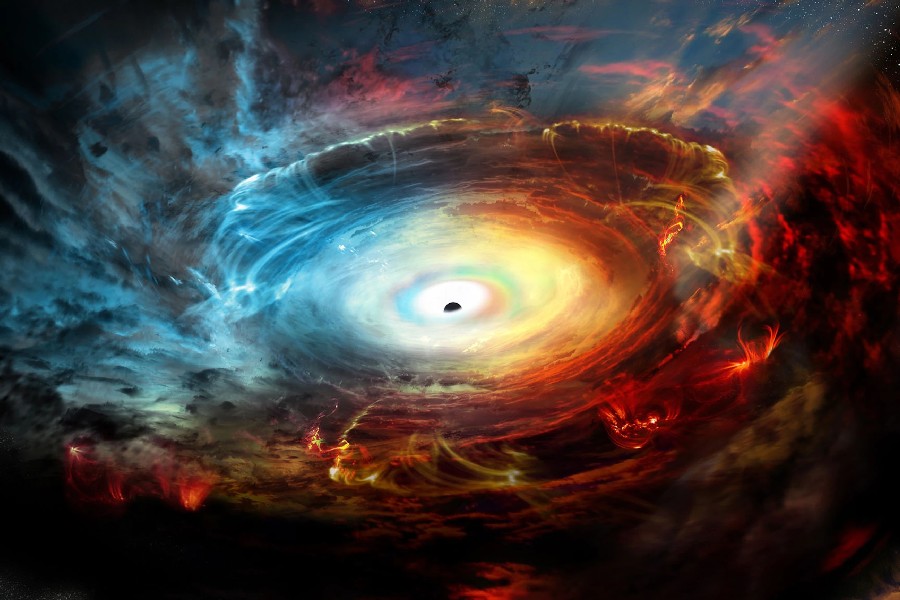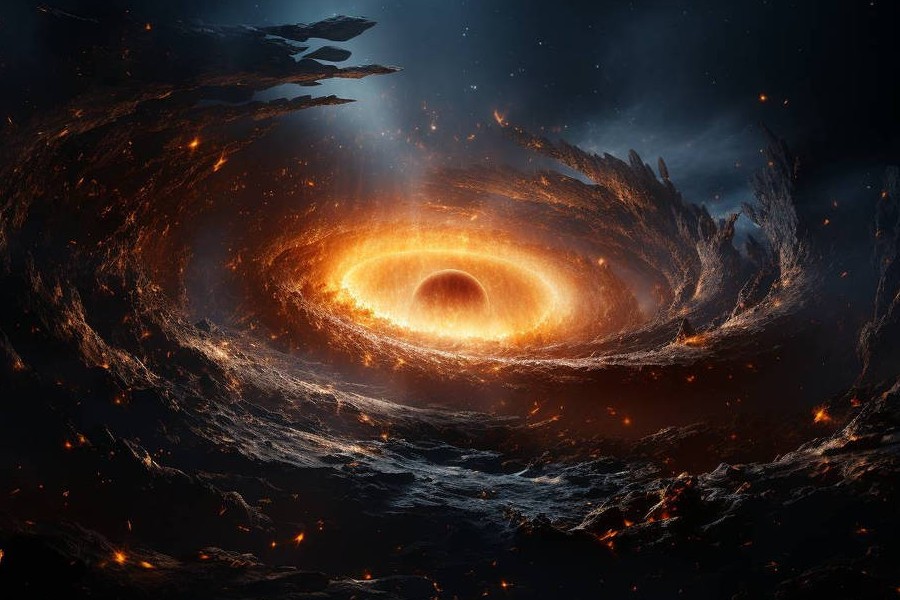Among the most mysterious phenomena in our universe are supermassive black holes, often lurking unseen in the centers of galaxies. These exotic objects possess gravity so intense that even light cannot escape once it crosses the boundary known as the event horizon. But what is event horizon black holes?
In this journey through the cosmic landscape, we will explore the captivating realm of event horizons, unraveling their mysteries and delving into their profound implications for our understanding of the universe. From the awe-inspiring depths of black holes to the tantalizing possibilities of wormholes and beyond, the concept of event horizons invites us to peer into the abyss of the unknown.
So, brace yourself as we embark on this voyage into the heart of darkness, where the allure of the event horizon beckons us to explore the frontiers of the cosmos.

Event Horizon Black Holes
The event horizon is characterized by the point of no return, where the gravitational pull is so intense that nothing, not even light, can escape. It effectively marks the boundary between the observable universe and the mysterious interior of a black hole. So, what is an event horizon?
An event horizon in black holes is a boundary in spacetime beyond which events cannot influence an outside observer. Once an object or light crosses this boundary, it is inexorably drawn toward the black hole’s singularity, the central point of infinite density.
History of event horizons in astronomy
The notion of event horizons emerged from early astronomical observations of celestial phenomena that were difficult to comprehend based on existing scientific knowledge. Ancient astronomers noted the existence of dark regions in the night sky, as well as stars that seemed to appear and disappear periodically.
In the 17th and 18th centuries, advances in optics and mathematics allowed more detailed studies of stars and other celestial bodies. Astronomers began to speculate about the true nature of these objects and the role of gravity in space. Concepts from physics regarding escape velocity and the speed of light also started to illuminate theories about compact stars and collapsed stellar cores.
However, the early interpretations were limited by the restricted observational evidence available. It would take major technological and scientific leaps to properly define and understand event horizons.
Key milestones leading to the modern interpretation
The early 20th century witnessed a series of groundbreaking discoveries that paved the way for our modern understanding of black holes. Some of them are the following:
General relativity and the event horizon
In 1915, Albert Einstein’s theory of general relativity provided a crucial foundation. His equations predicted the existence of an event horizon, a boundary around a massive object beyond which no information, not even light, can escape.
The Schwarzschild radius
Building on Einstein’s work, Karl Schwarzschild, in 1916, found a solution to the general relativity equations for the gravitational field of a compact, spherical object. This solution introduced the concept of the Schwarzschild radius, a critical distance marking the location of the event horizon.
Stellar limits and gravitational collapse
In the 1930s, Subrahmanyan Chandrasekhar researched stellar structure. This established a limiting mass for white dwarfs. It suggested the possibility of further collapse under extreme gravity. This concept laid the groundwork for understanding how massive stars could collapse into black holes.
Unveiling spacetime with Penrose diagrams
Roger Penrose, in the mid-20th century, made significant contributions using mathematical tools like spacetime diagrams. He explored the geometry of spacetime around collapsing objects, further solidifying the theoretical framework for black holes.
By the late 20th century, thanks to these crucial milestones, the existence of black holes gained widespread acceptance among scientists. This occurred even before their direct observation.
Formation of Event Horizon Black Holes
Black holes and their event horizons mainly come from massive stars collapsing under gravity when they run out of nuclear fuel. As a big star uses up its fuel, it loses the pressure that keeps it from collapsing.
When a star becomes heavy enough, usually around two to three times the mass of our Sun, gravity becomes stronger than the pressure pushing outward from electrons. This causes the star to collapse further, eventually forming what we call a singularity.
Formation of event horizons
The moment when a collapsing star forms an event horizon depends on its structure. In simpler models, this happens when the star’s radius becomes smaller than its Schwarzschild radius.
At this point, the speed needed to escape from the star’s surface exceeds the speed of light, trapping photons inside an expanding boundary. This boundary separates from the star’s surface, becoming the early stage of an event horizon.
As the star collapses, this boundary grows outward as the star’s area shrinks. Although more complex models show different density profiles, they still follow this basic process.
The outcome is a black hole with an event horizon beyond which no signals can reach external observers. Despite variations in initial conditions, gravitational collapse reliably forms an event horizon, isolating the black hole region from the rest of the universe.

Properties of Event Horizon Black Holes
Size and scale
The event horizon size varies with the black hole’s mass. Bigger black holes mean larger event horizons. Stellar black holes, which are smaller, range from 6 to 62 miles. (10 to 100 kilometers). On the other hand, supermassive ones in galactic centers can be millions or billions of kilometers wide.
Black holes bend space time drastically due to their massive gravity. This affects everything near the event horizon boundary. Gravity near the event horizon becomes extremely strong, similar to Earth’s gravity just a few nanometers above the surface.
Gravitational effects near the event horizon
As an object gets closer to the event horizon, time appears to slow down for it compared to observers far away due to gravitational effects. Near the horizon, the tidal forces increase sharply, causing objects to stretch out like spaghetti. This happens as matter and radiation are pulled and stretched into long streams swirling around the black hole before they cross the horizon.
When matter is pulled inward, it heats up significantly, emitting intense X-rays that are detectable from Earth. Friction between the falling particles outside the event horizon also generates jets of bright plasma shooting out along the black hole’s rotation axes.
Observational characteristics and methods
Modern telescopes can study black holes indirectly. They do this by observing phenomena such as emissions from their accretion disks, the movements of nearby stars and gas around them, measurements of gravitational lensing, and other effects resulting from the intense warping of spacetime near their event horizons.
Thanks to advancements in submillimeter very-long-baseline interferometry, scientists can now directly image black holes. These images show the silhouettes and shadowy features created by capturing photons at the event horizon.
These direct images have provided valuable insights into the properties of black hole event horizons. Additionally, further progress in gravitational wave astronomy is promising to reveal even more about these enigmatic regions.
Significance of Event Horizon Black Holes in Astrophysics
Role in our understanding of general relativity
The discovery of black holes with visible event horizons provides strong evidence for Einstein’s theory of relativity. These black holes have super-strong gravity that bends space and time, slows down time, and even bends light – all as Einstein predicted.
By studying what’s happening near the edge of a black hole, where these relativity effects are at their strongest, scientists keep testing and confirming Einstein’s groundbreaking theory of gravity. Every time we observe an event horizon, it proves that Einstein’s ideas about gravity are right on the mark.
Contributions to astrophysical phenomena
Galactic centers have supermassive black holes with huge event horizons, stretching billions of miles wide. These black holes produce energetic outflows and jets, likely causing the bright emissions we see from quasars and other active galactic nuclei.
Their strong gravity pulls in surrounding gas, dust, and stars, forming swirling disks around them. This process accelerates matter to incredibly fast speeds near the event horizon.
Smaller black holes also affect their surroundings significantly due to their gravity and accretion mechanisms. Studying how these black holes work helps scientists understand various phenomena seen throughout the universe.
Importance for theoretical models of the universe and cosmology
Our universe probably contains trillions of black holes with event horizons. These black holes play a crucial role in shaping gravitational structures throughout space. They are essential parts of our understanding of how galaxies and stars form.
Studying these black holes can give us insights into how galaxies, stars, and the patterns of cosmic background radiation came to be. These patterns have been present in the universe since the Big Bang.
Analyzing the event horizons of black holes is important for cosmological theories. These theories try to make sense of the dynamics and history of the universe from the earliest moments after the Big Bang.
Conclusion
Event horizon black holes offer pivotal clues into the origins and evolution of cosmic structures since the early universe. We hope this article has conveyed how the realization of event horizons from Einstein’s equations revolutionized our insight into singularities where the known laws of physics collapse.
The shadows and silhouettes they cast help scientists understand how black holes behave and grow over billions of years. This knowledge shapes the formations of galaxies and the background radiation that fills the universe.
By studying black hole event horizons throughout cosmic history, scientists can learn more about how the universe is structured and how it came to be. They can also understand the intense physics that controls supermassive objects at the centers of galaxies.
